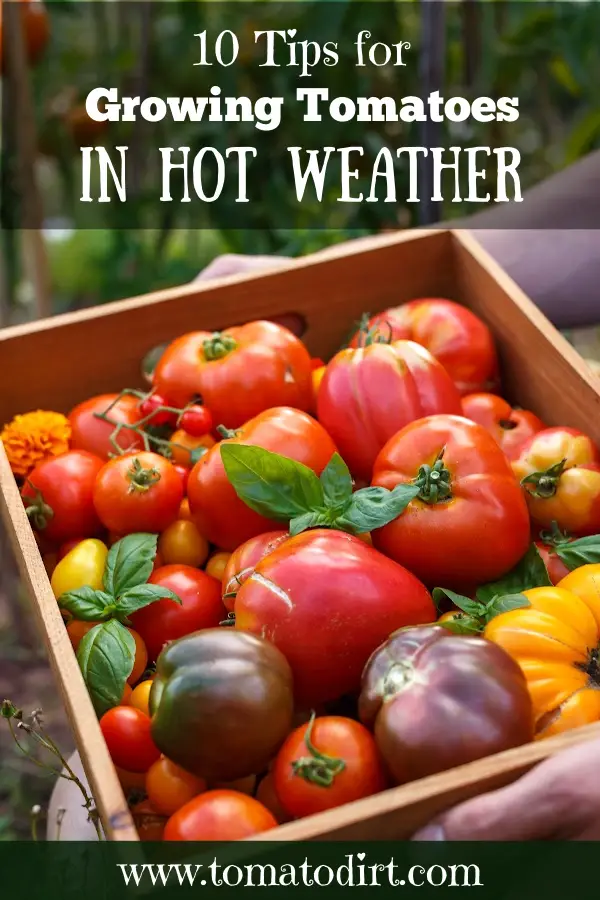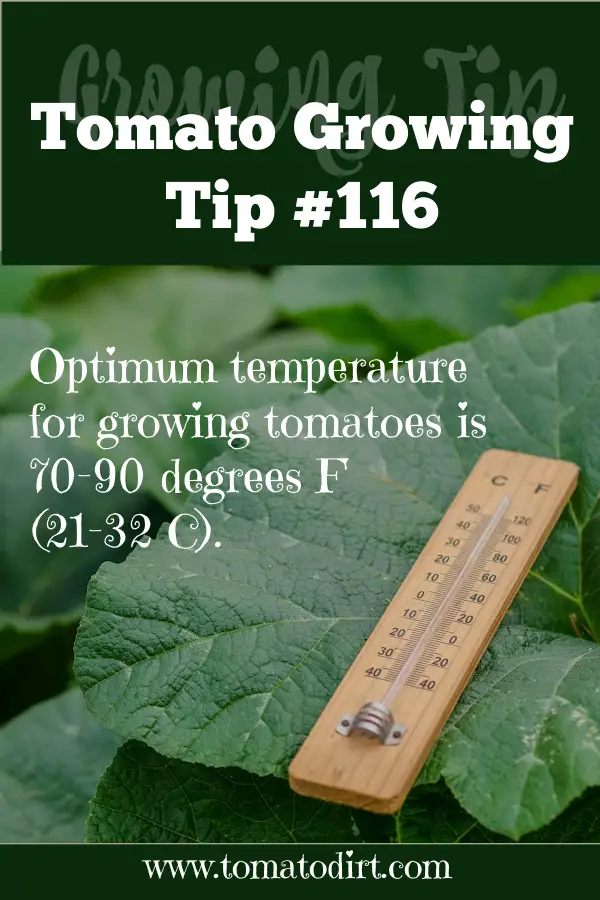FREE: 10 Must-Know Tomato Growing Tips Get The Guide
Read our affiliate disclosure here.
10 Tips for Growing Tomatoes in Hot Weather So Your Plants Can
Thrive
Since 2010, Tomato Dirt has garnered 4.8+ million views, making it the web’s leading online source for growing tomatoes in the home garden. Award-winning writer and Tomato Dirt owner Kathy Widenhouse has helped thousands of home gardeners grow healthier tomatoes. Be one of them when you get Tomato Dirt’s Growing Guide here.
Posted 7.10.25
Tomatoes love heat – to a point.
Growing tomatoes in hot weather is a tricky business. The plants thrive when temperatures hover between 70°F (21°C) and 90°F (32°C). But when the thermometer reads higher or lower on either extreme, you can expect problems like …
- Reduced fruit set. High temperatures, especially when combined with low humidity, can prevent viable pollen from forming. That hinders fertilization, leading to fewer tomatoes.
- Blossom drop. Even with "perfect flowers" that can self-pollinate, high heat can cause pollen to clump together, preventing successful pollination and causing blossoms to drop off the plant.
- Sunscald. Direct sunlight on fruits can cause sunburn and cracking, especially when temperatures are very high.
- Uneven ripening. Fruits exposed to high heat may develop color on the outside but fail to ripen properly inside. Ick.
- Lower production, lower fruit weight, fewer seeds per fruit. Above 84°F (29°C), the weight of individual tomatoes and the number of seeds per fruit tend to decrease.
You can’t control Mother Nature, but you can help your plants manage extreme conditions that come their way. Use these gardening tips to soothe your tomatoes’ frazzled leaves and plump their fruit when temperatures soar.
Top 10 tips for growing tomatoes in hot weather: FAQs
1. How much water do tomatoes need in hot weather?
In hot weather (above 85°F/29°C), tomatoes typically need 1.5 to 2 inches of water per week. Hotter than that, and they need more. When temperatures exceed 90°F (32°C), water your tomato plants daily. In containers or raised beds, you may need to water twice every day because they dry out so quickly.
Deep, consistent watering that reaches the root zone (6–8 inches deep) reduces stress for your tomato plants. Inconsistent watering can cause blossom end rot or splitting fruit. Mulching helps your plants retain moisture, so that’s another way to keep them hydrated.
2. What are the best tomato varieties for hot climates?
If you live in an area with a reputation for hot weather during the growing season, then plan ahead. Choose tomato varieties suited to hot climates. Tomatoes bred or known to perform well in heat include:
- Heatmaster
- Solar Fire
- Phoenix
- Florida 91
- Bella Rosa
- Arkansas Traveler
- Cherokee Purple
- Juliet (cherry)
- Porter
These tomato varieties are known for heat tolerance, disease resistance, and consistent fruit set even in high temps. Look for varieties labeled as “heat set” or “heat tolerant.”
3. How do you prevent tomatoes from wilting in hot weather?
When you’re growing tomatoes in hot weather, you can help prevent wilting when you …
- Water deeply and early in the morning to keep roots hydrated throughout the day.
- Apply 3–4 inches of mulch (like straw or shredded leaves) to insulate the soil.
- Use shade cloth (30–50%) during the hottest part of the day (1–4 PM) to reduce transpiration.
- Avoid damaging roots when cultivating around the plants.
- Ensure good drainage—wilting can also occur from root rot caused by excess water.
- Wilting in the heat may be temporary midday stress. If leaves perk up in the evening, the plant is coping.
4. What temperature is too hot for tomatoes?
Tomato plants begin to struggle when daytime temps exceed 90°F (32°C) and nighttime temps stay above 70°F (21°C) – for more than a couple of successive days. In those conditions, pollen becomes sterile. That means your plants struggle to set fruit.
Above 95°F (35°C), tomato plants often stop growing and flowers drop off. Prolonged exposure can damage your plant’s cells and slow fruit ripening. You can’t change the temperatures, but you can be aware of what your plants are experiencing.
5. How often should you water tomatoes in hot weather?
- In-ground plants: Water deeply 3–4 times a week in temperatures above 85°F.
- Raised beds: Water every 1–2 days depending on soil drainage and mulch use.
- Containers: Check soil daily. You may need to water every day or even twice daily during extreme heat.
To check, use the “finger test.” If the soil is dry 2 inches down, it's time to water. And water deeply. Avoid superficial watering or mere sprinkling, which encourages shallow roots. Tomato plants grow extensive root systems to reach nutrients and moisture far below the surface.
6. What are signs of heat stress in tomato plants?
Look for these common signs of heat stress:
- Leaf curling (upward) to reduce sun exposure.
- Wilting even when soil is moist.
- Blossom drop or poor fruit set.
- Yellowing leaves or dry leaf edges.
- Sunscald—white or pale patches on fruit.
- Slowed growth or no ripening.
Plants may survive heat stress but reduce production if high temperatures continue.
7. How can you protect tomato plants from sunscald in hot
climates?
- Use shade cloth (30–50%) or garden fabric over hoops to block intense sun.
- Mulch to protect roots and reduce heat reflected from the ground.
- Stake or trellis plants to lift fruit off the ground and reduce heat exposure. Leaves and branches in upright plants shade the lower ones.
- Avoid heavy pruning; leaves help shade the fruit.
- Plant taller companion plants (like sunflowers or pole beans) nearby to create natural shade.
8. What nutrients do tomatoes need in hot weather?
In hot conditions, tomatoes benefit from:
- Potassium (K): Supports heat and drought tolerance, fruit quality, and disease resistance.
- Calcium (Ca): Prevents blossom end rot, especially important in dry conditions.
- Phosphorus (P): Aids root development and flower/fruit production.
- Magnesium (Mg): Important for photosynthesis; yellowing between leaf veins may indicate deficiency.
- Micronutrients (Boron, Zinc): Help with pollen development and fruit set.
Give your tomato plants these yummy nutrients by using a balanced fertilizer (5-10-10). Supplement calcium and magnesium when you have a prolonged heat wave or when your soil test indicates a deficiency. But avoid over-fertilizing with nitrogen, which can lead to excessive leafy growth.
9. How do you keep tomatoes cool in extreme heat?
- Install temporary shade (30–50% shade cloth) during peak heat hours. Or place sun barriers over plants – such as folding chairs when plants are not yet too tall.
- Mulch heavily to insulate roots and maintain moisture.
- Avoid black plastic mulch which retains heat—opt for light-colored ground cloth, straw, or light-colored mulches which will reflect the heat and sun.
- Water early morning or late evening to reduce evaporation.
- Mist the foliage to cool plants during a heat wave, but only in non-humid climates. Live in a humid area? Choose another cooling method, like electric fans – or you’ll encourage the spread of disease.
- Use windbreaks if hot, dry winds are an issue.
10. What is the best time of day to water tomatoes in hot
weather?
Early morning (between 5–9 AM) is best for watering tomatoes. This timing allows water to soak deep into the soil before the sun evaporates it. Plus, early morning watering gives your plant’s foliage time to dry, which prevents fungal diseases. And you help plants to face the heat of the day with full hydration.
Extra tip: Avoid watering in the evening in hot, humid
climates, as wet leaves can invite fungal issues overnight.
Extra tips for growing tomatoes in hot weather
- Choose large pots for container tomatoes. Start out with the largest container possible. When high temperature arrive mid-season, you’ll be thankful. ensure adequate soil volume for water retention and consider watering twice a day in extreme heat.
- Pick fruit early. Harvest tomatoes when they show some color to prevent sunscald and ensure they ripen properly.
- Monitor for pests and diseases. Stress from the heat reduces your plants’ ability to fend off diseases and pests.
- Pause the pruning. Wait until temperatures level off before giving your tomato plants a trim. Pruning can stress the plant during hot weather.
- Use bio-stimulants. Some gardeners find that adding seaweed extract to the water can help tomato plants tolerate heat stress.
More about Growing Tomatoes in Hot Weather
Shading tomatoes: reduce their stress, keep them going in the heat ...
Is it too hot for tomatoes? How to know, what to do ...
Heat-tolerant tomato varieties ...
Use This 6-Step Checklist for Tomato Plant Care ...
Best and worst companion plants for tomatoes ...
Is It Ripe? When To Pick Tomatoes ...
Get more tips on our Tomato Growing Tips Pinterest board...
Return from Tips for Growing Tomatoes in Hot Weather to Tomato Dirt home
As an Amazon Associate and Rakuten Advertising affiliate I earn from qualifying purchases.
SHARE THIS PAGE:
FREE! 10 Must-Know Tomato Growing Tips: 20-page guide
Get yours here:





